SUB 1, the Student Union Building: Expansion of Student Spaces on the George Mason Campus
The J.C., or Johnson Center, is currently the central part of the George Mason campus. It is a space for students to study, grab food, hang out, promote activities, host meetings, and it houses various administrative offices. But the J.C. was not always the center of student life on campus. For a long period during the 1970s and 80s, the SUB 1 building was the center of student activities and attracted commuter students to stay on campus longer than just for class.
Picture sitting in a small basement with limited seating and presumably a small area to grab food. This was all that was provided for students at the beginning of Mason’s history on the Fairfax campus. Even with this significant upgrade to the basement of the South Building, time went on and the admissions doubled, causing major space issues. In the 1970s the Chancellor described the hazards of this enclosed space. The space became so crowded and overrun that it was a breeding ground for germs and maintenance issues. 1
Oral History interview with University President Vergil Dykstra. Interviewed by Jennifer Janes, February 18, 2010.
SUB 1 was a building designed early in Mason’s history: it was first suggested in 1967. The actual construction was delayed for around seven years due to money and other construction the administration deemed a priority. When first requested on January 30, 1967 for a Capital Outlay request, a student center was the third priority for the 1968-1970 agenda.2 It was not until the August request, that the building became the first priority in the 1970-72 Capital Outlay project.3 This suggests that the administration predicted the growth, but knew they could hold off on construction for a while. Evidence also indicates that for this building to be constructed per the request of the students it was going to have to be paid for partially by the students.4 In this case it would be a 60 dollar fee per student in addition to other administrative and school costs, which would be placed into bonds to accumulate interest. The goal was to reduce it to 45 dollars, as Chancellor Thompson suggested that the fee would be too much for the students in addition to the tuition, other student fees, and books for their courses. But they needed a building, and even a cheap small one would be better than nothing.5 As time went on it became clear: a larger and more permanent student center building would be needed as the student population grew.
The first blueprint that was made shows a substantially smaller and simpler student building than the one that was actually built. It was a smaller, cheaper building, and the proposed site was behind the Lecture Hall (a present day Starbucks).6 As time went on, the administration saw the urgency and importance of this building. Even with the burden of cost, a permanent and more expansive blueprint was made in 1971. This changed the face of the building along with the site. It was placed across from Fenwick Library and completed what many call the quad, which was at the center of campus. This calls attention to the idea of the student center becoming more central and expanding with student demands. This new plan showcased the true vision Mason administration had for the University and its expanding community. The student building housed many things that would give the University a place to attract students to stay, grow, and expand the campus.
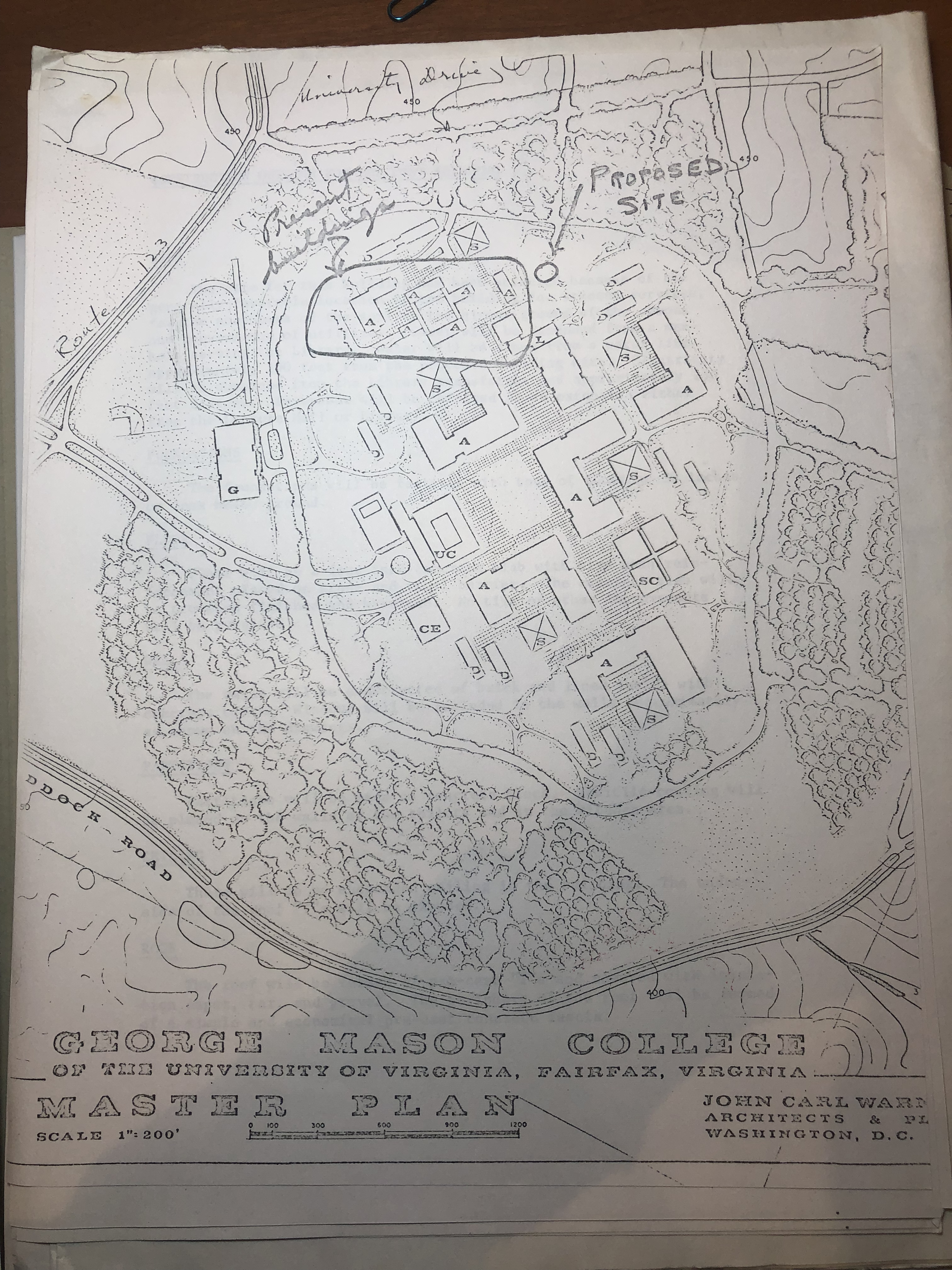
Figure 1. The original plans for a student center. Bailey and Pye Plans, University of Virginia Albert & Shirley Small Special Collections Library, University of Virginia Albert & Shirley Small Special Collections Library, Box 32, Folder 7, January 21, 1971.
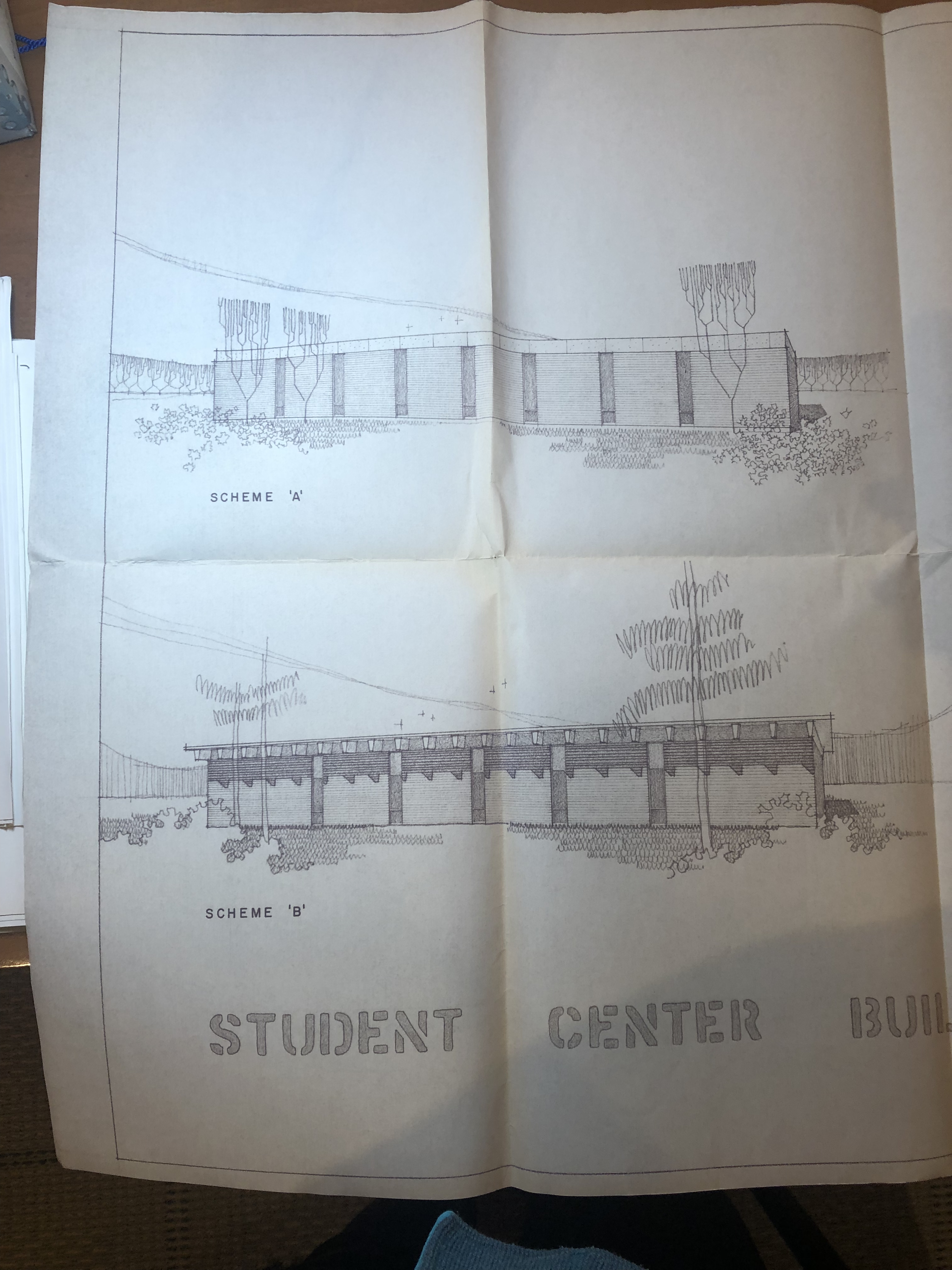
Figure 2. Map of the original proposed site for the student center. John Carl Warn Architects Map, George Mason College of the University of Virginia Master Plan Map, University of Virginia Albert & Shirley Small Special Collections Library, George Mason College General Records (Office of the Assistant Provost), Box 32, Folder 7, January 21, 1971.
Nineteen seventy-four saw the official opening of the first part of the Student Union building. One newspaper article described the opening with around 300 students, faculty and staff arriving at the building, listening to a speech and being greeted with free coffee and beer. The article emphasizes the important fact that the SUB building was the first construction at Mason with a non-academic goal; it was designed purely as a space for commuter students to congregate. The article even suggests that when the students are off campus, the building could be used by and for the local community, an important aspect of Mason’s interaction with the communities beyond the campus. The most interesting part of the building opening was the fact that it was still being constructed at the opening itself. Builders worked on finishing the second part of construction as the speeches were held and it was to be completed a year later.
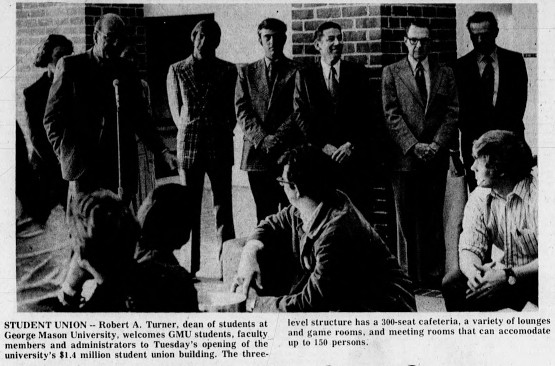
Figure 3. Photo and caption describing the dean and students seeing the opening of the building. This photo was on the first page of the local Northern Virginia Sun, demonstrating the impact this building had on the community. Northern Virginia Sun, Volume 37, Number 115, May, 16 1974.
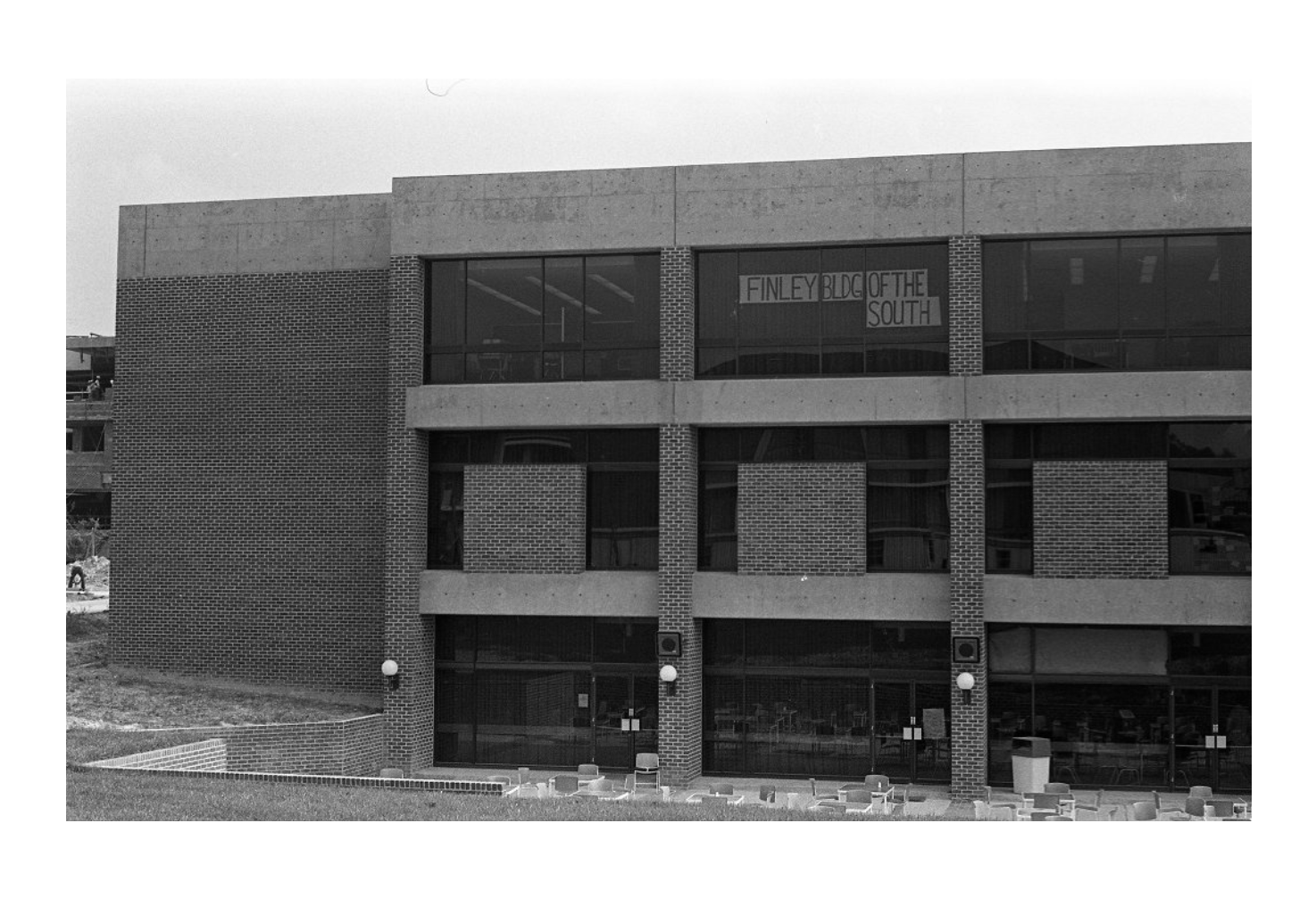
Figure 4. Photo of the outside of the SUB building. In the bottom right corner, the outdoor patio outside of the cafeteria is visible. On the upper floors, through the window, chairs and office space for the students are visible. Student Union Building, Keith Dorset, George Mason University Broadside Photograph Collection, Box 9, Page 14, September 17, 1974.
A pamphlet for the building began to circulate around 1974, which described each room. The pamphlet describes the building’s cost at $1,479,000. It described offices such as Career Planning, Financial Aid and Placement, Campus Ministry and the University Union Director. Its hours of operation were 7 am to 11pm or even midnight.6 The pamphlet itself indicates how central this building was meant to be, not only for the school but for the community. It held the bookstore, lounge area, a banquet hall, kitchen, TV and reading rooms, and rooms for administrators. There were even suggestions of a bank, and one memo suggested that in 1970 a post office should be included.7 Another interesting letter even described a beer tap being placed in the building.8 These services and suggestions show this building was meant to provide services to the students that are not within walking distance so they would not need to drive off campus. By providing this on campus, the students would not have to leave and they could keep the population in one place. This in turn can create an environment for student interactions and club expansions, which can be a real attraction for a college experience.
6 Pamphlet, George Mason University Facilities Management records (1952-2003), George Mason University Libraries Special Collection Research Center, Box 32, Folder 7.
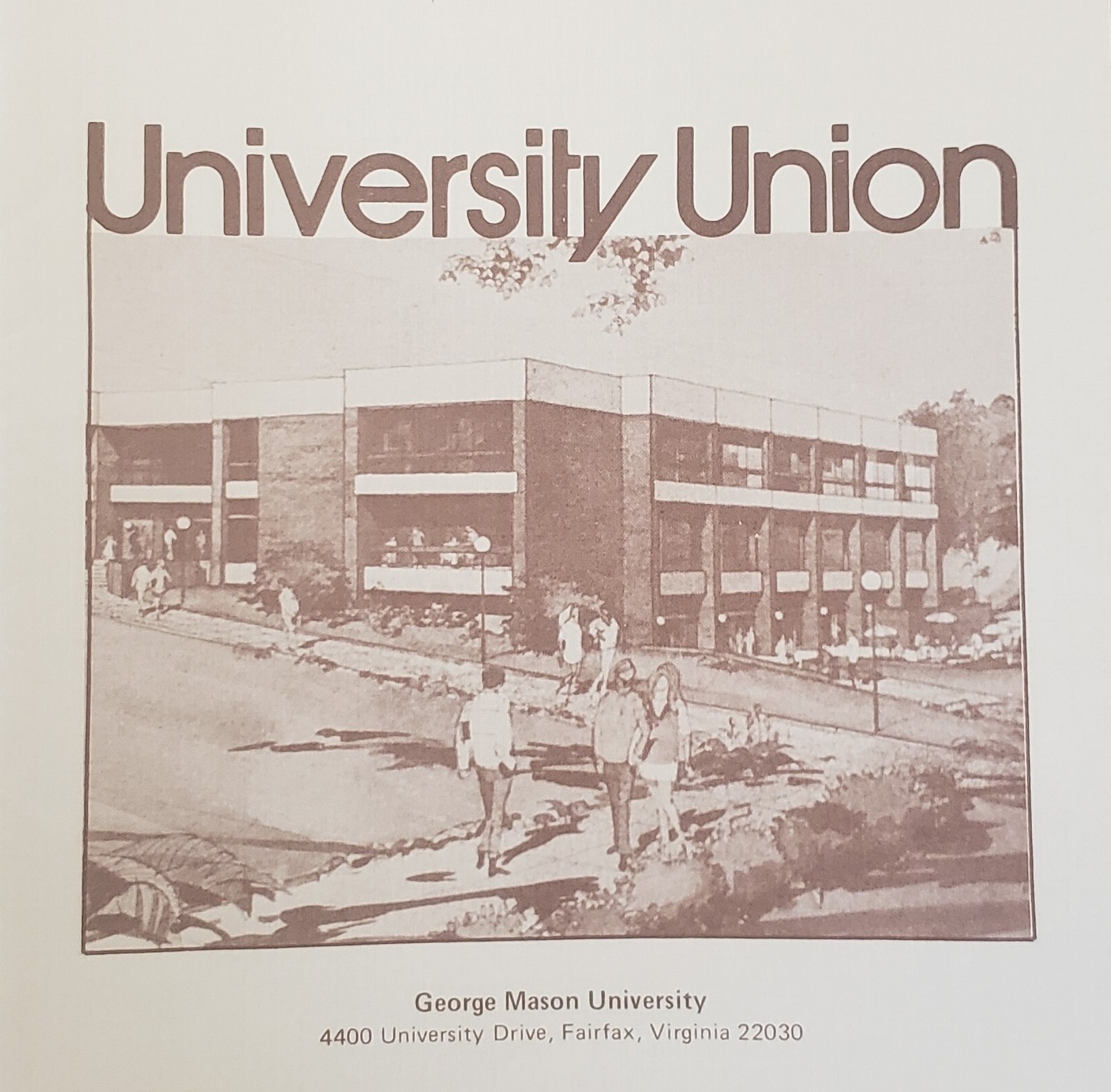
Figure 5. Pamphlet for the University Union or Student Union building. George Mason University Facilities Management records (1952-2003),George Mason University Libraries Special Collection Research Center, Box 32, Folder 7, ca. 1974.
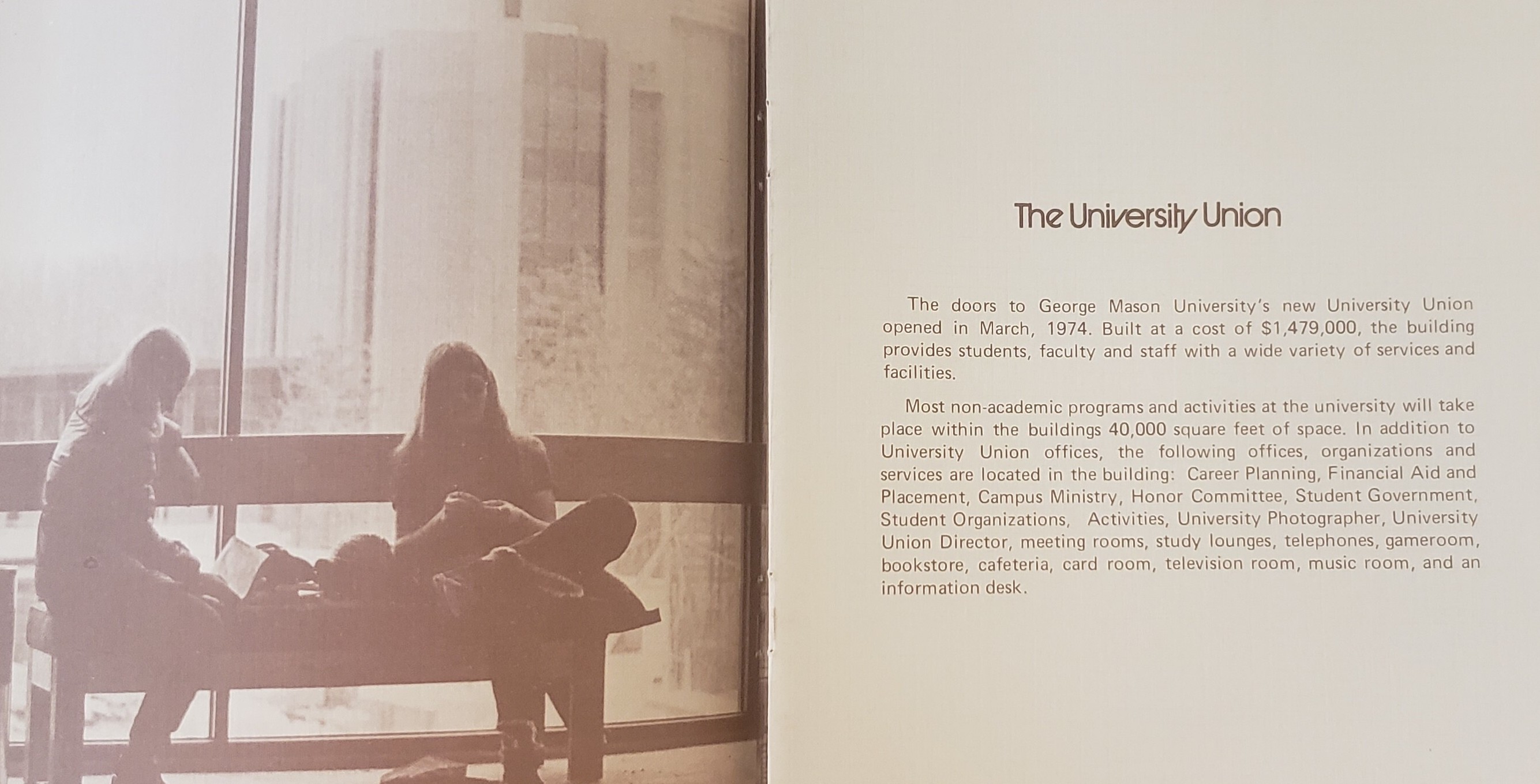
Figure 6. Pamphlet for the University Union or Student Union building. George Mason University Facilities Management records (1952-2003),George Mason University Libraries Special Collection Research Center, Box 32, Folder 7, ca. 1974.
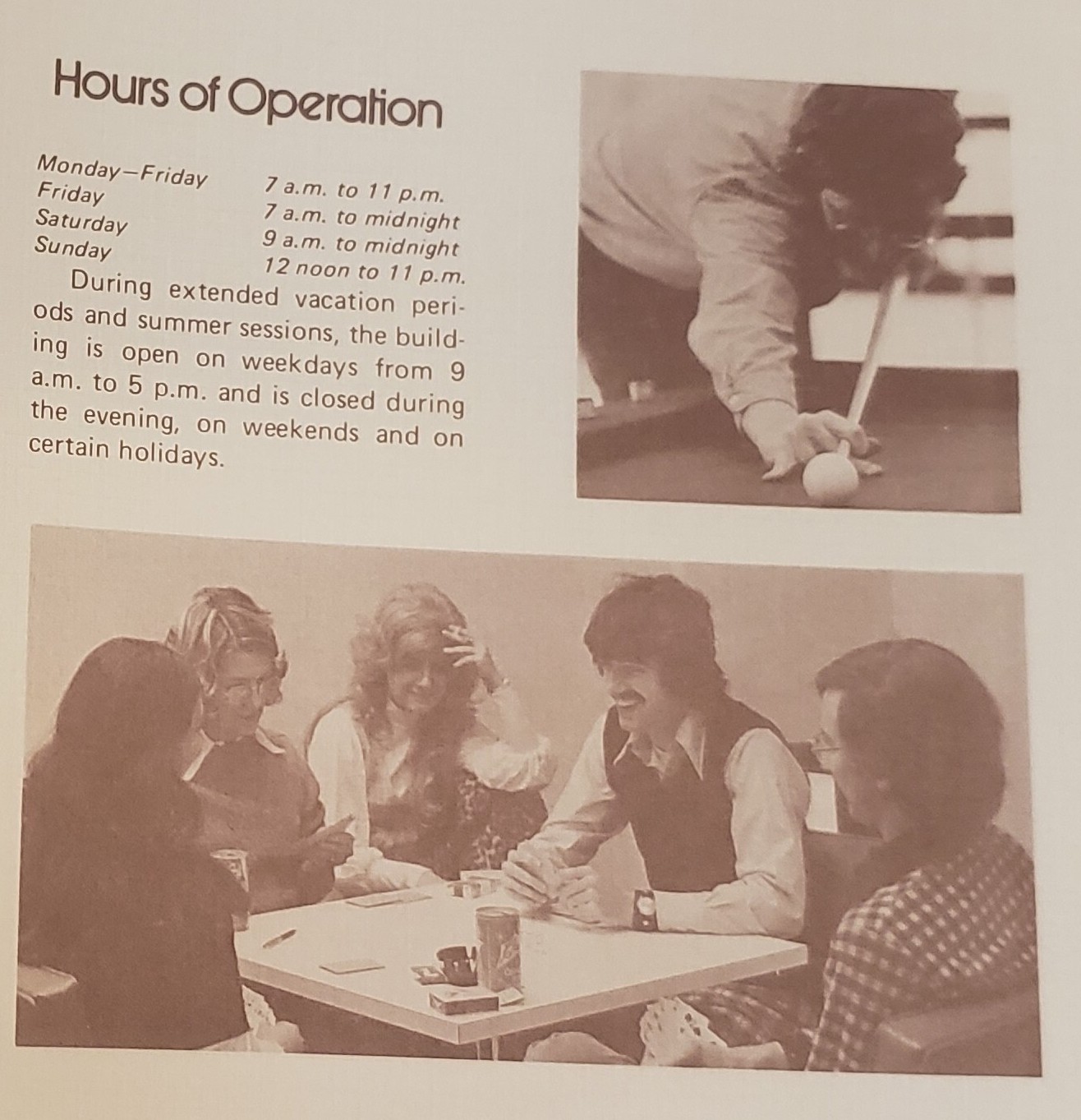
Figure 7. Pamphlet for the University Union or Student Union building. It mentions the hours and amenities included in the building. George Mason University Facilities Management records (1952-2003),George Mason University Libraries Special Collection Research Center, Box 32, Folder 7, ca. 1974.
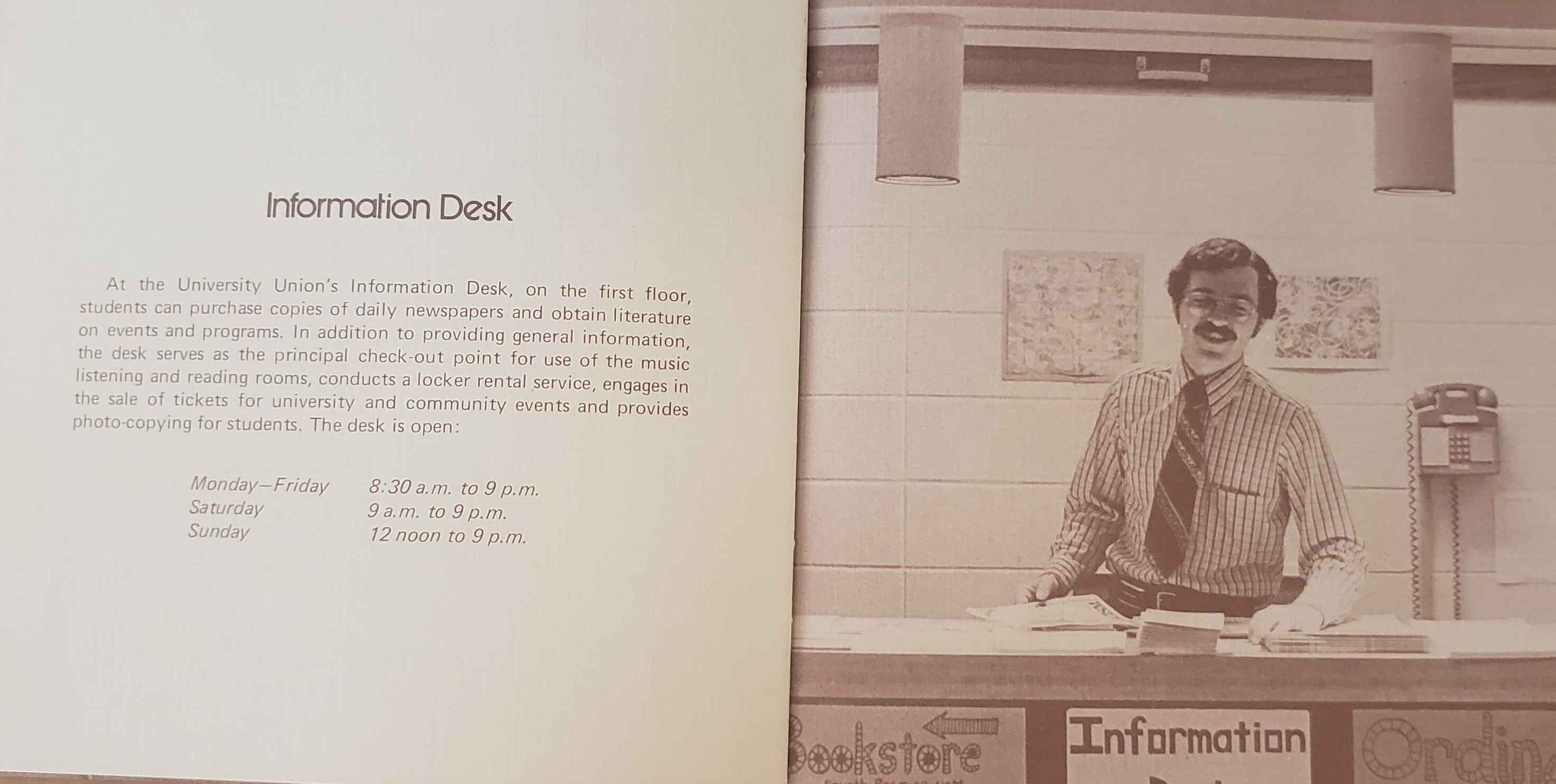
Figure 8. Pamphlet for the University Union or Student Union building. It mentions the hours and amenities included in the building. George Mason University Facilities Management records (1952-2003),George Mason University Libraries Special Collection Research Center, Box 32, Folder 7, ca. 1974.
Broadside articles and historical photos show us what the campus building was actually used for by students. Based on these photos it is clear how central this place was on campus, not just inside the building itself but outside as well. There were many photos that showcase the events that were held. From club affairs, to concerts, to simply an area for the students to talk, the students utilized the space often. The photos of the indoor space showcase a selection of events that ranged from entertainment to networking. For networking there was the example of career day, similar to the career booths and job events that are hosted on present day campus. There were dances and singing events hosted in the main lobby. These events, which incorporated both Mason students along with local groups, show the ties between Mason and the community.

Figure 9. Choir performance held in the lobby of the SUB building. George Mason University Broadside Photograph Collection, George Mason University Libraries Special Collections & Archives, Box 16, Page 90, April 15, 1978.

Figure 10. Club Day at the SUB Building. George Mason University Broadside Photograph Collection,George Mason University Libraries Special Collections & Archives, Box 17, Page 24, Frame 12, September 24, 1978.

Figure 11. Career Day at the SUB Building. George Mason University Broadside Photograph Collection, George Mason University Libraries Special Collections & Archives, Box 11, Page 51, Frame 1, October 10, 1975.
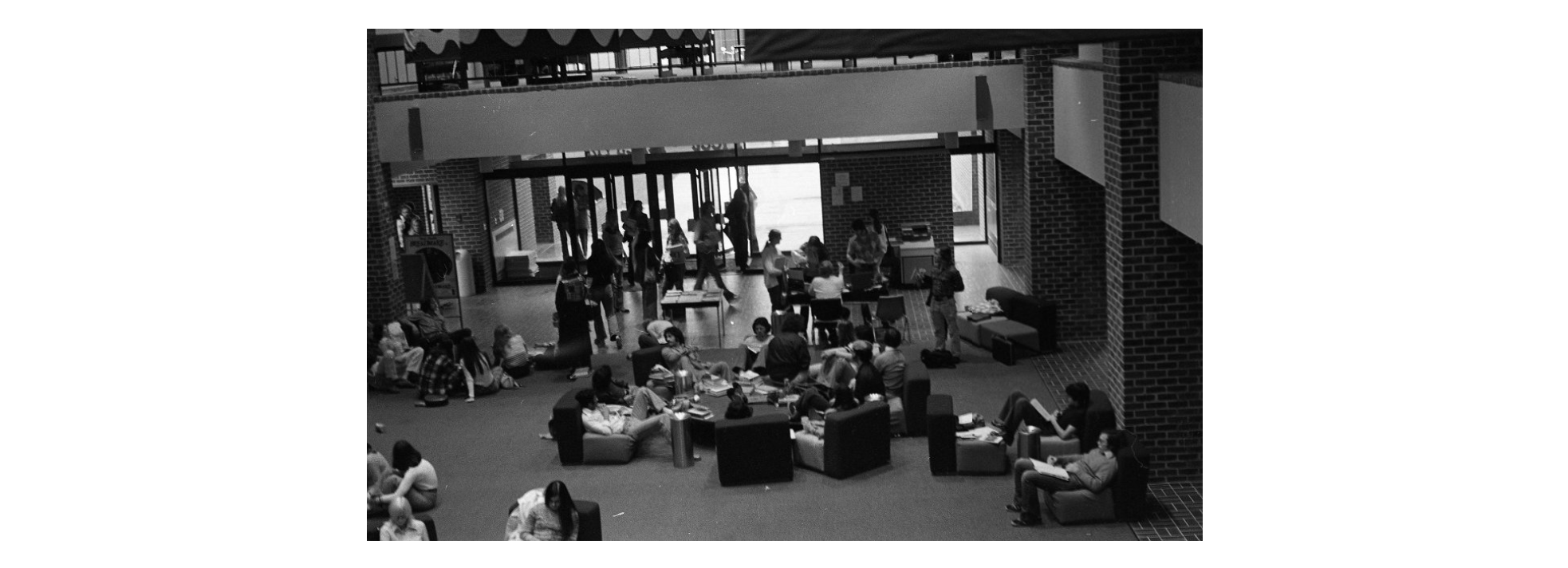
Figure 12. Students sitting in the lounge area of the SUB building. George Mason University Broadside Photograph Collection, George Mason University Libraries Special Collections & Archives, Box 11, Page 41, Frame 18, September 24, 1975.
The outdoor events that took place outside SUB 1 showcased a different kind of community spirit. There were often protests that surrounded the building, as the members of the community held signs and formed groups in solidarity. They also appeared to hold speeches outside the building in order to contain the crowd. Even Mason Day was held around this important building. SUB 1 also hosted outdoor seating right outside the cafeteria, which gave students another space to socialize with each other. This completed the center of campus known as the quad, which gave students a space to interact and protest in solidarity.

Figure 13. A group of students gather outside SUB 1 for a religious rally. George Mason University Broadside Photograph Collection, George Mason University Libraries Special Collections & Archives, Box 19, Page 24, Frame 25, October 12, 1979.

Figure 14. Children holding “Say Day Care Center” signs outside SUB 1. George Mason University Broadside Photograph Collection, George Mason University Libraries Special Collections & Archives, Box 18, Page 36, Frame 3 A, April 11, 1979.

Figure 15. Students hanging out in the outside lounge area of SUB 1. George Mason University Broadside Photograph Collection, George Mason University Libraries Special Collections & Archives, Box 9, Page 6, Frame 28, September 1, 1974.
In 1978, one interesting memo between President Krug and the Vice President of Business and Finance discusses continued construction at SUB 1. They discussed a rush repair that was necessary for the building——the mortar was not secure and had ruined the integrity of the brickwork. Since the memo was sent in April of 1978, it would have been four years after the initial building opening that said brickwork problem was addressed.6 The fact that this was not properly done in the first place and had to be dealt with four years later shows that the process of building SUB 1 was somewhat rushed and had to be patched up later.
The SUB building is a central part of Mason and what the campus is today. For a long period it was the center of campus, placed right across from the library and next to the original four buildings. As the physical center of campus has changed, so has the role of the SUB 1 building. Even if it still holds some of the same services, such as food, a doctor’s office and lounge area, it is no longer where the students congregate. Even though it does house a student favorite, Chick-fil-a, and some people go to this space, it is no longer the main student center on ca mpus. Even with this change, SUB 1 played an important role in altering the campus forever. After its construction, students could eat on campus, stay on campus, and feel a connection to campus. While classes are an important part of education, one of the most significant ways to connect to a college is through social interaction and student activities. If Mason never built the SUB 1 building, what clubs would exist today on campus? Would the students have interacted at all? What lasting impression would be left by Mason? SUB 1 was central to the creation of Mason’s campus culture and to building community relations in the Northern Virginia area as well, at least before the creation of student housing. It even leads to the question: would student housing have been possible without these services for students on campus? It is clear how important the SUB 1 building became to students on the early George Mason campus.
Catalina Mayer is an undergraduate history major at George Mason University who will receive a Bachelor of Arts in History in the summer of 2022. She also studies communication and hopes to continue her education in law school or graduate school.
Suggested citation
Please use the following as a suggested citation:
Catalina Mayer, "SUB 1, the Student Union Building: Expansion of Student Spaces on the George Mason Campus," Mapping the University, Roy Rosenzweig Center for History and New Media, George Mason University (2022): <https://mappingtheuniversity.rrchnm.org/narratives/gmu-sub1/>.
Lorin Thompson Letter, George Mason College General Records (Office of the Assistant Provost), University of Virginia Albert & Shirley Small Special Collections Library, Box 1, Folder Building and Land Matters, February 1,1971. ↩︎
Capital Outlay Request, George Mason University Facilities Management records (1952-2003), George Mason University Libraries Special Collection Research Center, Box 32, Folder 7, January 30, 1967. ↩︎
Capital Outlay Request, George Mason University Facilities Management records (1952-2003), George Mason University Libraries Special Collection Research Center, Box 32, Folder 7, August 1970-72. ↩︎
H. P. Adams Letter, George Mason College General Records (Office of the Assistant Provost), University of Virginia Albert & Shirley Small Special Collections Library, Building and Land Matters, Box 1, September 10, 1970. ↩︎
Lorin Thompson Letter, George Mason College General Records (Office of the Assistant Provost), University of Virginia Albert & Shirley Small Special Collections Library, Box 1, Folder Building and Land Matters, February 1,1971. ↩︎
Bailey and Pye Building Plan, University of Virginia Albert & Shirley Small Special Collections Library, University of Virginia Albert & Shirley Small Special Collections Library, Box 32, Folder 7, January 21, 1971. ↩︎
George Mason Board of Visitors Notes, George Mason Board of Visitor Meeting Minutes, George Mason University Libraries Special Collection Research Center, Box 2, Folder 17, April 10, 1974. ↩︎
Bachschmid Glover INC Memo, George Mason University Facilities Management records (1952-2003), George Mason University Libraries Special Collection Research Center, Box 32, Folder 7, March 28, 1974. ↩︎